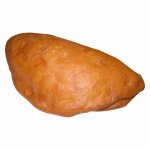Empanadas?
Similar concept, but notably different ingredients. (For the culturally deprived, think of the frozen "pot pies" you get at the supermarket, but without the gelatinous gravy, and with different ingredients. More on this in a moment.)

The pasty as I know it is said to have originated in Cornwall, at the far southwest tip of Britain. God created the Cornish miners' dinner pail in the shape of a pasty, and the Cornish miners' wives have had the wifely duty of filling said dinner pails with pasties ever since. A thick, suet-based crust helped keep the contents warm through a work shift and provided calories for a man whose daily work involved turning big rocks into small rocks, using muscles and a heavy hammer. The filling inside the crust consisted of bite-sized meat pieces, and an assortment of root vegetables - also in 1/4 to 1/2 inch sizes. Pasties are made to be held in one hand and eaten a bite at a time; dishes and utensils were for quiche-eaters and other wimps who worked above ground. One pasty is an entire meal.
Since miners of the 17th and 18th centuries tended to have large families and small pay, their wives tended to make pasties from whatever could be obtained. As I heard it, Satan himself never visited Cornwall for fear that a burly miner would lay hold of him and his wife would - shall we say - get him very personally involved in the pasty-making process.
The tin and copper mined in Cornwall were strategic materials for a sea-going nation, but as England became a colonial power in the 18th and 19th centuries, Cornishmen were often recruited as foremen and supervisors in underground, hard-rock mining operations. That's how the pasty came to the iron and copper mines of the Lake Superior district in the mid 1800's. The Cornishmen were highly respected as experts in the field of mining, and subsequent waves of immigrants tended to emulate whatever they did - including what they ate for lunch.
The Finns are the ethnic group that tended to remain in the district. Their pasties used the vegetables familiar to them in Scandinavia. You always find onions and potatoes in pasties. You'll also find some combination of rutabaga, turnip, and carrot, though not necessarily all three. The meat is beef, or a mixture of beef and pork up to 50/50. The culturally and sociologically inclined claim they can tell the ethnic lineage of the recipe (Cornish, Finn, Irish, other U.K., Swede, south European, etc) by which ingredients are used, and their proportions. I suspect that none of the original homelands would say our pasties are "correct" - our recipes borrow from several cultures but are ultimately American.
Pasties are commonly associated with Michigan's Upper Peninsula (a.k.a., "The State of Superior") and the Minnesota Iron Range. You can find them anywhere from high-class restaurants, to little roadside shops whose menu has but two entries: pasties, and coffee. They are a staple of Church picnics, Scout suppers, and charitable organizations of every stripe who want to raise a little cash. Ex-patriots can even have them shipped to your home, ready to be thawed and reheated ( http://www.pasty.com/order.html ). I have also encountered them in Central City, Colorado, and the Missouri Lead Belt.
Pasties are a blue collar, working man's meal. They may not be elegant food, but they are REAL food.
https://www.google.co.uk/imgres?img...d=0ahUKEwjF95v36_vKAhVF8RQKHfz5BCoQMwgkKAAwAA
Cornish pasties are still very popular in the UK! Such shops have inevitably evolved(?) into selling different varieties - curry, veggie, chicken etc
Cornish pasties are still very popular in the UK! Such shops have inevitably evolved(?) into selling different varieties - curry, veggie, chicken etc
Last edited:
Cornish pasties are still very popular in the UK! Such shops have inevitably evolved(?) into selling different varieties - curry, veggie, chicken etc
Ditto for Michigan, especially the Upper Peninsula. There are also a few pasty shops downstate, even where I live near Detroit. In fact there is one about 6 miles away.
My wife was a Yuper (Urban Dictionary: yuper) and we've enjoyed home made versions of her family Pasty recipes and variations on them for decades.
Cornish pasties are still very popular in the UK! Such shops have inevitably evolved(?) into selling different varieties - curry, veggie, chicken etc
Pasties are some of the greatest food ever! Given that anything wrapped in pastry is good it stands to reason that anything wrapped in pastry you can eat whilst out and about is even better!
Food migration is an interesting topic. Pasties in the midwest makes a lot of sense as some states round there have almost as many immigrant Finns than are left in Finland (much like the Irish, but for different reasons)
When I used to visit Finland a lot I loved these https://en.wikipedia.org/wiki/Karelian_pasty BUT you had to find good ones. Bad ones were like eating a moccasin with rice pudding in it.
Bad ones were like eating a moccasin with rice pudding in it.
Getting a good pasty in a commercial pasty shop can be hard if you don't know the lay of the land. When we are in the UP we drive past many establishments for exactly that reason.
The result described above can be far from an exagerration, unfortunately.
It almost seems axiomatic that anything that can give great pleasure, can also be botched and be actually quite the horror.
In a case of convergent evolution the Italians came up with the calzone for the same reasons the Cornish developed their pasty ie lunch at work:
IME not all that convergent.
The Pasty crust is generally far thicker and more flaky, while the filling is heavily tilted towards vegetables: carrots, onions, rutabagas, and potatoes. Oh there is meat and also maybe some butter or lard, but not nearly as much meat as I've had with Calzone. The Calzones I see and sometimes eat are mostly filled with cold cuts and cheese slices, all baked and melted together: mmmmmmmmmmmmmmm!
IME not all that convergent.
The Pasty crust is generally far thicker and more flaky, while the filling is heavily tilted towards vegetables: carrots, onions, rutabagas, and potatoes. Oh there is meat and also maybe some butter or lard, but not nearly as much meat as I've had with Calzone. The Calzones I see and sometimes eat are mostly filled with cold cuts and cheese slices, all baked and melted together: mmmmmmmmmmmmmmm!
Almost exactly like convergent evolution works in living beings:
If they fill the same niche they will end up looking very similar while on the inside they can be very, very different.
Take the thylocene for example. It filled the niche of wolves, looked like a wolf but on the inside it was a marsupial.
The calzone fills the niche of a pasty, it looks like a pasty but on the inside it's a pizza.
PS: An italian calzone contains normally contains little meat in the form of prosciutto or salami. Basically anything you would find on a pizza in Italy ie not a lot of meat in any case.
The calzone in my earlier picture is an apulian calzone fritto which is fried rather than baked on holds nothing but tomato and mozzarella inside.
I certainly learned something today. I was not aware the 'Pasty' was any kind of food.
Wait until you find out how it's pronounced.
I certainly learned something today. I was not aware the 'Pasty' was any kind of food.
If you consider 'food' to be man size hunks of dead mammal, it's not!
There is of course the pasty's stodgier cousin, the roly poly, which is made with suet. Both sweet (jam) and savoury (usually bacon and onion) forms exist. I was told that was a traditional food to be lobbed across the dykes in norfolk, but no certified references to that. Bacon and Onion Roll ( roly poly ) - Feed Your Family for £20 a week
Note properly done is steamed not baked. I am sure it is against the geneva convention nowdays tho
Wait until you find out how it's pronounced.
You mean 'pus-tea'?
At least there is no mayo in them. ;-)
Btw what is the other meaning alluded to?
My dictionary only gives the food definition.
If you consider 'food' to be man size hunks of dead mammal, it's not!
I guess not enough was said about vegetarian, turkey, and chicken pasties, the former of which is more common around here. Some say I make a tasty turkey pasty.
But there are no politics with me, and deer, beef, and pork are welcome on my plate any time.
Also, some meat pasties are made from ground meat so the chunks of mammal aren't all that man-sized when they exist. Even when the meat is not ground, the usual convention is to dice it pretty fine.
You mean 'pus-tea'?
Interesting. I'm used to 'pass-teh'.
No matter what, saying 'paas-tee" marks you as a troll.
Urban Dictionary: Yooper
Btw what is the other meaning alluded to?
It is a covering that strippers use over their nipples. Generally decorative.
I guess not enough was said about vegetarian, turkey, and chicken pasties, the former of which is more common around here.
Probably because all this started with the Cornish Pasty which has a very closely defined content of beef, turnip, potato and onion seasoned lightly with salt&pepper. Cornish Pasties are protected under the EUs Protected Geographical Indication scheme, just like french cheeses.
I guess not enough was said about vegetarian, turkey, and chicken pasties, the former of which is more common around here. Some say I make a tasty turkey pasty.
.
I more meant that Cal might view 'food' as being (say) a 12-16oz lump that you could tell the source animal from. Trad pasties have a very low meat to veg ratio, which was the main point of them. Stodge to fill up, with enough meat so you could taste it. Same reason for yorkshire pudding or the xmas plum pudding.
It is a covering that strippers use over their nipples. Generally decorative.
I think they are called (nipple) tassels here.
- Home
- Member Areas
- The Lounge
- The food thread

